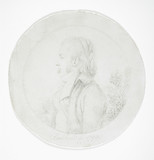Rembrandt Peale was the preeminent American portraitist working in the neoclassical style. His father, Charles Willson Peale (1741-1827), was at the time of Rembrandt’s birth the best-trained artist in the country, since JOHN S. COPLEY had left Boston for Europe. Rembrandt learned to draw at the age of eight and at thirteen painted his first self-portrait. At sixteen he became a professional portraitist. In 1795 he had his first portrait sitting with President George Washington, which was the beginning of a lifelong interest in an ideal image of the great man, culminating in his often-replicated Patriae Pater portrait of about 1824 (Pennsylvania Academy of the Fine Arts, Philadelphia). He painted in South Carolina in 1795 and then in Baltimore and again in Philadelphia. In 1798 he married Eleanora Mary Short.
In 1801 he accompanied his father to Newburg, New York, where he assisted with the exhumation and reconstruction of two mastodon skeletons. He exhibited one of these in 1802 in London, where he also studied briefly with BENJAMIN WEST in 1803. In 1808 and again in 1809 he visited Paris; here his mature style began to coalesce under the influence of French neoclassicism. After his return to Philadelphia in 1810, he attempted to establish himself as a history painter with his large work, The Roman Daughter, 1811 (National Museum of American Art, Smithsonian Institution, Washington, D.C.). In 1814 he opened in Baltimore a museum of painting and natural history and in 1816 helped to found the Gas Light Company of Baltimore. In 1822 he sold the museum to his brother Rubens and returned to painting full time. In the following years he traveled to New York, where he became a founding member of the National Academy of Design, and to Boston, where he experimented with lithography. In 1828 he traveled in Europe, principally in Italy, returning to New York in 1830. The following year he published his Notes on Italy. In 1832 he was again in Europe, painting portraits in London. Returning to New York in 1834, he published a drawing manual, Graphics, that was reprinted nineteen times and was an important high-school textbook throughout the latter half of the nineteenth century. In 1836 he became president of the American Academy of Fine Arts. In 1846 he was again in Philadelphia, where he published Portfolio of an Artist. In the late 1850s he published his "Reminiscences" in The Crayon and frequently lectured on his portraits of Washington.
BIBLIOGRAPHY
Philadelphia, American Philosophical Society, Peale-Sellers Papers § C. Edwards Lester, The Artists of America: A Series of Biographical Sketches of American Artists (1846; reprint, New York: Kennedy Galleries and Da Capo Press, 1970), pp. 199-231, with Peale’s autobiography and Lester’s comments on The Court of Death, 1820 (Detroit Institute of Arts) § Eleanor McSherry Fowble, "Rembrandt Peale in Baltimore," Master’s thesis, University of Delaware, 1965, with bibliography, appendixes of reprinted letters § Lillian B. Miller, ed., The Collected Papers of Charles Willson Peale and His Family (Millwood, N.Y.: Kraus Microform for National Portrait Gallery, Smithsonian Institution, 1980) § Philadelphia, Historical Society of Pennsylvania, Rembrandt Peale, 1778-1860: A Life in the Arts, exh. cat., 1985, with essays by Carol Eaton Hevner and Lillian B. Miller, catalogue by Hevner and Carrie H. Scheflow, bibliography.

